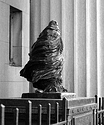Yes, in theory. The reason for the difference in light is due to the inverse square law. Basically, the further you go out, the more the light is dispersed across an ever increasing image circle. So as the image circle expands, the intensity of light will be at any one point on the circle will be reduced. Basically, there will be fewer photons per square inch if you increase the square inches without increasing the number of photons. And the opposite would also apply. If you're shrinking the area of the image circle without changing the number of photons, then you'll get more photons per square inch. Whether or not it's enough to be worth calculating, is another story. You can look up the inverse square law to get the formula, its fairly simple to use. But that's the principle on which bellows extension is calculated, and yes, it does work both ways.
Now, as others have stated, since all large format 90mm lenses that I'm aware of actually focus to infinity somewhere around 100mm (you'll have to look up the specs on your specific lens), you'll want to calculate the distance against the actual point of infinity focus, and not the labeled focal length on the lens. Also, as others have stated, you're not going to have anything in focus (which I'm assuming is what you're trying to accomplish here).





